#Sestertius
Explore tagged Tumblr posts
Text
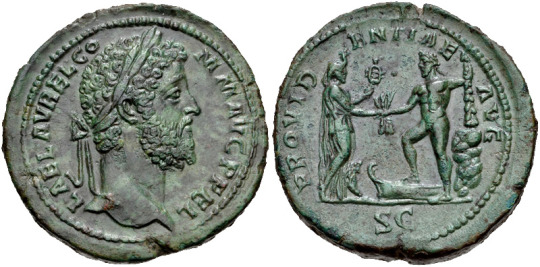
Sestertius of the notorious Roman emperor Commodus, minted at Rome in 192 CE, the last year of his reign. On the obverse, the bust of Commodus; on the reverse, the personification of Africa greets Hercules. Africa holds a sheaf of wheat (representing the grain the province produced) and a sistrum (the rattle associated with the goddess Isis), while Hercules stands on a ship's prow and holds his club.
The seemingly innocuous imagery of this coin masks the megalomania that characterized Commodus' final years. He is here styled Lucius Aelius Aurelius Commodus, his birth name; his father Marcus Aurelius had renamed him M. Aurelius Antoninus Commodus upon making him Caesar, but Commodus ultimately spurned both this name and his father's heritage. His identification with Hercules, a constant of his reign, reached a fever pitch at this time: the emperor officially styled himself "Roman Hercules" (Hercules Romanus) and engaged in beast-hunts (venationes) and gladiatorial matches designed to evoke Hercules' Twelve Labors. (In one infamous incident, he threatened to cast the audience in the arena as the Stymphalian Birds and mow them down with arrows.) Taking a dizzying array of new cognomina (Amazonius, Invictus, Exsuperatorius, etc.), Commodus demanded that each month of the year be named after one of his titles, and he even floated the idea of renaming Rome Colonia Aelia Commoda after himself. By December 192 his advisors had had enough, and a conspiracy was put in train, into which his mistress Marcia was recruited. She poisoned him; when this did not kill him, his personal trainer, one Narcissus, strangled him in his bath. With him ended the dynasty begun by Nerva nearly a century before.
Photo credit: Classical Numismatic Group, Inc. http://www.cngcoins.com
#classics#tagamemnon#Ancient Rome#Roman Empire#ancient history#Roman history#Commodus#art#art history#ancient art#Roman art#Ancient Roman art#Roman Imperial art#Hercules#classical mythology#coins#ancient coins#Roman coins#Ancient Roman coins#sestertius#metalwork#brass#brasswork#numismatics#ancient numismatics
165 notes
·
View notes
Text

Exceptional bronze Medallions 57,58 g; minted in Rome , For Philip the Arab (Marcus Julius Philippus) was a Roman Emperor who ruled from 244 to 249 CE. Obverse scripted : CONCORDIA AVGVSTORVM. Tiered: the draped armored bust of Philip the Arab with laurel wreath and the draped bust of Otacilia Severa with diadem, bust view to the left. Opposite: the draped armored bust of his son Philip II with laurel wreath, bust view. On Reverse scripts : SAECVLARES // AVGG. Chariot race in the Circus Maximus. In the front three teams to the right, one to the very left in the front view. In the middle ground the spina with palm tree and other architecture. In the background the stands and several buildings.
#archaeology #history #ancient #art #Caesar #ancienthistory #archaeological #rome #italy #roman_empire #roma #heritage #roman_republic #archaeologylife #Orichalcum #Roman_mythology #italia #medallion #romancoin #romanarcheology #romanancientcoins#aureus #denarius #dupondius #follis #antoninianus #sestertius #fils #alsadeekalsadouk #الصديق_الصدوق
#sestertius#alsadeekalsadouk#الصديق_الصدوق#romancoin#history#archaeology#photography#culture#travel#roman coins#palestrina#greek coins
4 notes
·
View notes
Text
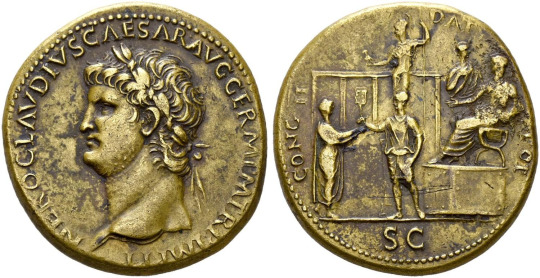
Nero sestertius struck at Lugdunum in 64 CE. Reverse depicts a "congiarium" distribution scene, in which the emperor makes donations to the citizens of Rome. Two citizens can be seen in the center, one handing a tessera to the other, Minerva can be seen in the background. Nero is situated on the reverse seated to the far right, the supervisor of grain standing behind him. Reverse legend reads "CONG II DAT POP"

Nero sestertius struck at Lugdunum in 66 CE. Reverse depicts another "congiarium" scene. Nero seated in a chair to the far left with one of his officials situated on another platform to his right, handing out congiarium (a donation) to a Roman citizen. The goddesses Libertas and Minerva are seen in the background. Legend reads "CONG I DAT POP".
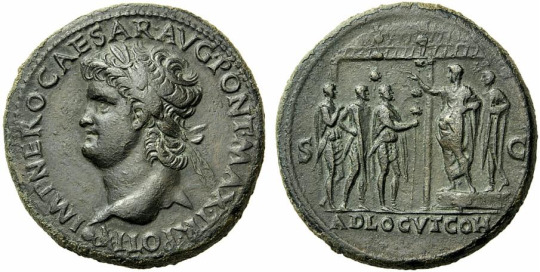
Nero sestertius struck at Lugdunum in 66 CE. Reverse is an ADLOCVT (addressing the cohorts) type, a reverse that pops up quite a bit on Roman sestertii throughout the years. Nero is center right on the reverse, raising his hand and addressing three soldiers. Legend reads "ADLOCVT COH".
#ancient coins#roman empire#roman history#roman art#ancient history#ancient art#ancient rome#sestertius
26 notes
·
View notes
Text
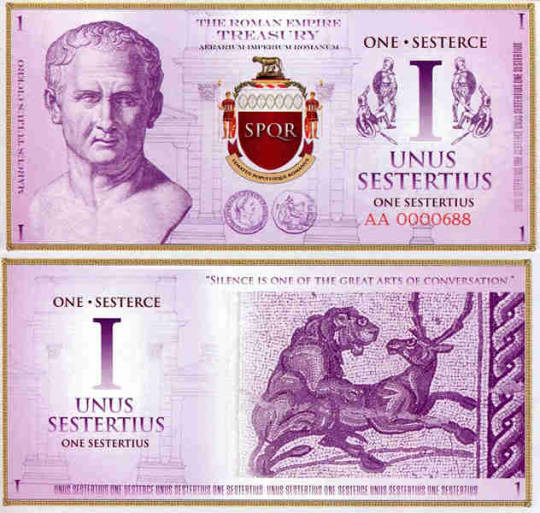

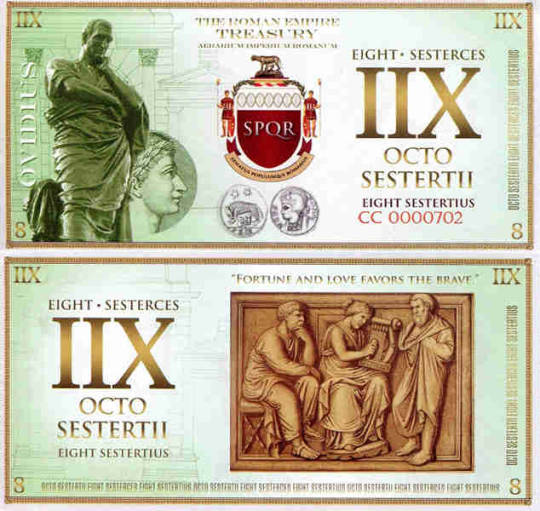

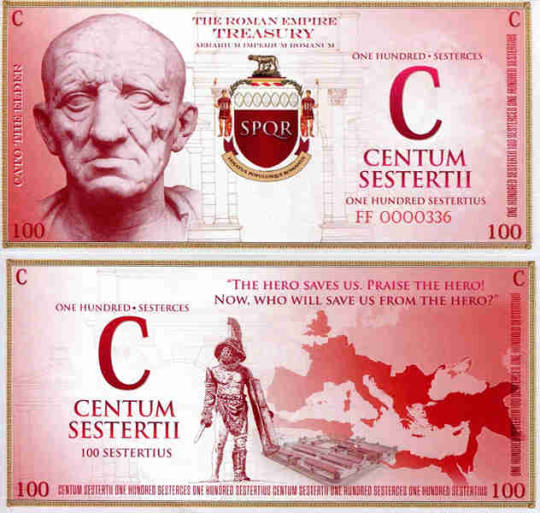
Themed fantasy private issue notes: The Roman Empire, currency sestertius.
#Roman Empire#private#fantasy#fancy#fantazyjny#sestertius#banknote#note#not circulated#nieobiegowy#for collectors#kolekcjonerski#banknot#ancient Roma
0 notes
Photo

Trajan Æ Sestertiu Rome, AD 104-107 25.77g, 33mm
Trajan (18 September 53 – August 117) was Roman emperor from 98 to 117. Officially declared optimus princeps ("best ruler") by the senate, Trajan is remembered as a successful soldier-emperor who presided over one of the greatest military expansions in Roman history and led the empire to attain its greatest territorial extent by the time of his death. He is also known for his philanthropic rule, overseeing extensive public building programs and implementing social welfare policies, which earned him his enduring reputation as the second of the Five Good Emperors who presided over an era of peace within the Empire and prosperity in the Mediterranean world.
#Trajan#Trajan Æ Sestertiu#Rome AD 104-107#coin#collectable coin#ancient artifacts#archeology#archeolgst#history#history news#ancient history#ancient culture#ancient civilizations#ancient rome#roman history#roman empire#roman emperor
36 notes
·
View notes
Text

at this point saying #hand theory is just too obvious. but anyway. #hand theory
#svsssposting#also if i had a sestertius for every mxtx novel that involved a fight against a guy who had an arm reattached#that would be three whole sesterces#hand theory#beeps
4 notes
·
View notes
Text

Bronze sestertius of Trajan A.D. 103–111 x
128 notes
·
View notes
Text

Mark Antony and Octavia. Late summer-autumn 38 BC. Æ Sestertius (34mm, 22.68 g, 2h). Fleet coinage. Uncertain mint in the Peloponese; Obv. L. Sempronius Atratinus, auger and consul designatus . M • ANT • IMP • TER • COS • DES • ITER • ET • TER • III • VIR • R • P • C, Bare head of Mark Antony right, facing draped bust of Octavia left / L • ATRATINV[S • AVGVR • COS • DESIG], Two standing figures (Antony and Octavia?) in quadriga of hippocamps right; HS in left field, Δ and astragalus(?) below. Green and brown patina. Extremely rare.
#mark antony#marcus antonius#octavia#marc antony#second triumvirate#numismatics#coins#ancient coins#rome#roman history#ancient rome#roman republic#roman empire#ancient history
10 notes
·
View notes
Text
Coin of the Day #126 (9/7/2024)
Popular game show, Wheel of Fortuna…


Roman Empire
AE Sestertius - 30mm 18.11g
Gordian III 244 AD
Rome Mint
Obverse IMP GORDIANVS PIVS FEL AVG
Bust of Gordian III right, laureate, draped, cuirassed
Reverse FORTVNA REDVX S C
Fortuna seated left, holding rudder and cornucopiae, wheel under seat
RIC VI 331a
#coin of the day#roman empire#ancient rome#gordian iii#rome#roman coins#coin#coins#numismatics#ancient coins
9 notes
·
View notes
Text

Sestertius of the Roman emperor Gaius, better known as Caligula (r. 37-41 CE). This coin highlights the exceptional honors Gaius bestowed upon his three sisters. While the obverse features the traditional laureate bust of the emperor, the reverse features his sisters together, each identified with the personification of a Roman virtue: Agrippina as Securitas, Drusilla as Concordia, and Julia as Fortuna. Each sister holds a cornucopia to demonstrate abundance, while Drusilla also holds a patera (flat serving dish used in Roman religious rites) and Julia holds a rudder (to symbolize safe guidance of the ship of state). Photo credit: Classical Numismatic Group, Inc. http://www.cngcoins.com
#classics#tagamemnon#history#ancient history#Ancient Rome#Roman Empire#Roman history#Julio-Claudian#Caligula#Gaius#art#art history#ancient art#Roman art#Ancient Roman art#Roman Imperial art#artifact#coins#ancient coins#Roman coins#Ancient Roman coins#sestertius#metalwork#bronzework#numismatics#ancient numismatics#Roman numismatics
68 notes
·
View notes
Text

Colored project for #Julia_Domna , she was Roman empress consort from 193 to 211. She was born in Emesa in Roman #Syria to an Arab family of priests of the deity Elagabalus. In 187, she married Libyan-born #Septimius_Severus, who at the time was governor of the Roman province of Gallia Lugdunensis. They had two sons, #Caracalla and #Geta. #archaeology #history #ancient #art #Caesar #ancienthistory #archaeological #rome #italy #museum #roma #heritage #Orichalcum #antiquity #italia #medallion #romancoin #romanarcheology #romanancientcoins#aureus #denarius #dupondius #follis #antoninianus #sestertius #Julia_Domna
0 notes
Text
Portraits of Elagabalus, every year

Denarius of Diadumenian, most notable for not being Elagabalus.
This extremely rare coin was struck between May and July 218 during his father Macrinus's war against Elagabalus and Julia Maesa, and portrays Diadumenian as a full blown emperor (coins of him as Caesar are much more common).
This coin is a prime example of the Severan art style when it came to portraying younger rulers, as even though Diadumenian was not a Severan, his portrait is incredibly similar to that of teenaged Caracalla/Geta and Elagabalus.

Aureus of Elagabalus, 218-219. Reverse depicts Elagabalus flanked by two soldiers, legend reads "FIDES MILITVM"
Portrait resembles the style used for Macrinus.

Aureus of Elagabalus, 219. Reverse depicts Roma seated left.

Aureus of Elagabalus, 220. Reverse shows the conical stone of Emesa, Elagabalus's famous prized rock (its the blob thing behind the eagle, I know, its hard to make it out) riding in a slow quadriga.
At this point we're getting depictions of Elagabalus that are probably closer to what they actually looked like.

Sestertius of Elagabalus, 221, reverse depicts the emperor sacrificing from Patera over altar.

Aureus of Elagabalus, 222. Obverse portrait features bust of Elagabalus laureate, bearded and facing right. Reverse portrays the emperor sacrificing from a patera over an altar to El-Gabal or Sol Invictus.
At this stage of their life Elagabalus was in complete eastern sun god priest mode, as seen on these "SACERDOS" types that are very common for their silver issues.
An interesting piece of this portrait is the weird strand on Elagabalus's head above the V in ANTONINVS. This is usually referred as "The horn", which is most likely supposed to be the penis of a bull.
#ancient coins#ancient rome#ancient art#roman history#roman art#ancient history#aureus#sestertius#elagabalus
28 notes
·
View notes
Note
SALVE! puto Scipionem Aemilianum absolvere necesse esse. bonus civis Romanus est, unusque Scipionum; non hunc condemnemus! QUOQUE, tibi dabo et omnibus iudicibus multam pecuniam, si iudices hunc reum exonerabunt. tibi… HS CCC dono dabo?
salve! literally so true and i agree completely but like. i think you are vastly overestimating the purchasing power of the sestertius. like HS CCC is not exactly Multa Pecunia :/ bigger bribe please
52 notes
·
View notes
Text
if i had a sestertius for every time someone tripped and told everyone it was a good omen, i'd have two sestertii, which isn't a lot, but it's weird that it happened twice
26 notes
·
View notes
Text

Ten sestertius for whoever scopes this shout-out
4 notes
·
View notes
Text

Roman Emperor Hadrian Coin Found at Carlisle Archaeological Dig
A LOCAL metal detectorist has unearthed a unique Roman coin displaying Emperor Hadrian whilst at Carlisle’s Roman Bathhouse dig site in the Cricket Club grounds.
he coin, part of the Uncovering Roman Carlisle project, is said to be one of the most significant of the coins found by the team of archaeologists and volunteers, known as The Diggers.
The coin features Emperor Hadrian, who reigned from AD 117 to 138 and ordered the construction of the nearby Hadrian's Wall.
The reverse side depicts Fortuna, the Roman goddess of chance, fate, and fortune.
Dan Bell, from Carlisle, who has been metal detecting for four years and involved in the archaeological dig site for the past two years, made the discovery.
"I just thought it was your average Roman coin," Dan said.
"They've found many in better condition, but because of what is on it, it's special.
"Frank (Wardell), who organises the digs, thinks it’s the best one we’ve found so far."
Despite finding numerous medieval coins from the reigns of Edward I, Elizabeth I, and Charles I, Roman coins have been much rarer in his collection.
"The only Roman ones have been at the bathhouse," Dan said.
One commenter on social media indicated the coin was a 'sestertius', saying four of these were equivalent to a day's pay for a Roman soldier.
The coin adds to more than 4,000 significant finds at the site, including more than 700 Roman coins, painted wall plaster, military artefacts like arrowheads and spear tips, over 400 hairpins, imperial stamped tiles, North African-style roof tubes, glass beads, gaming pieces, and a rare Roman doll’s foot.
By Paul McTaggart.


#Roman Emperor Hadrian Coin Found at Carlisle Archaeological Dig#Emperor Hadrian#Carlisle’s Roman Bathhouse dig#coins#collectable coins#roman coin#metal detecting#metal detecting finds#ancient artifacts#archeology#archeolgst#history#history news#ancient history#ancient culture#ancient civilizations#roman history#roman empire#roman emperor
33 notes
·
View notes